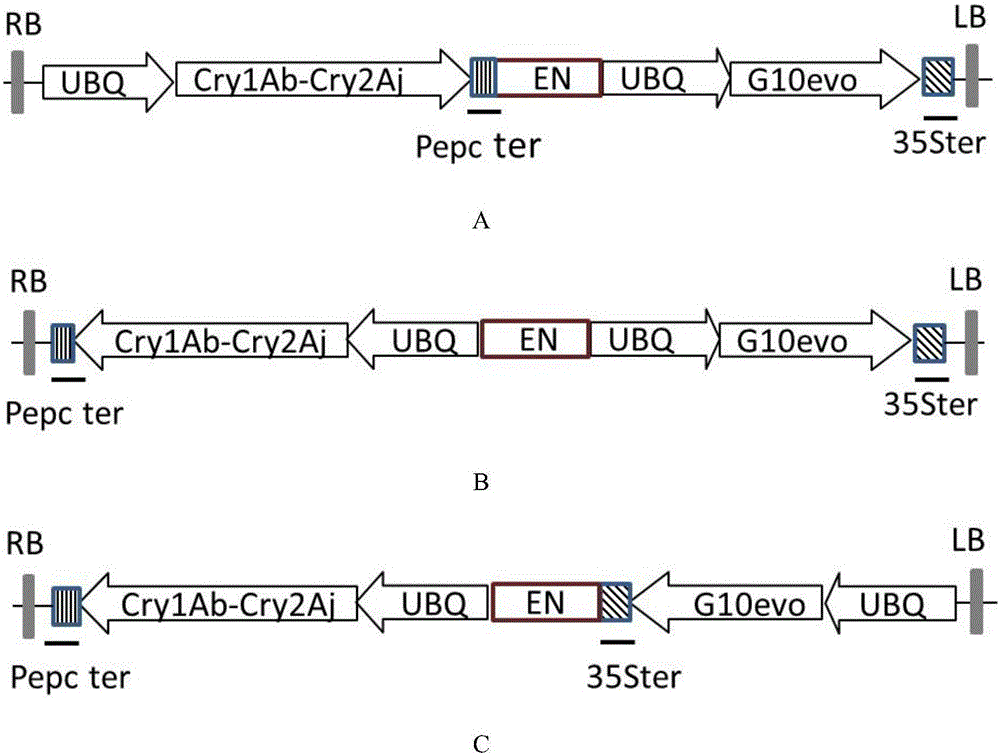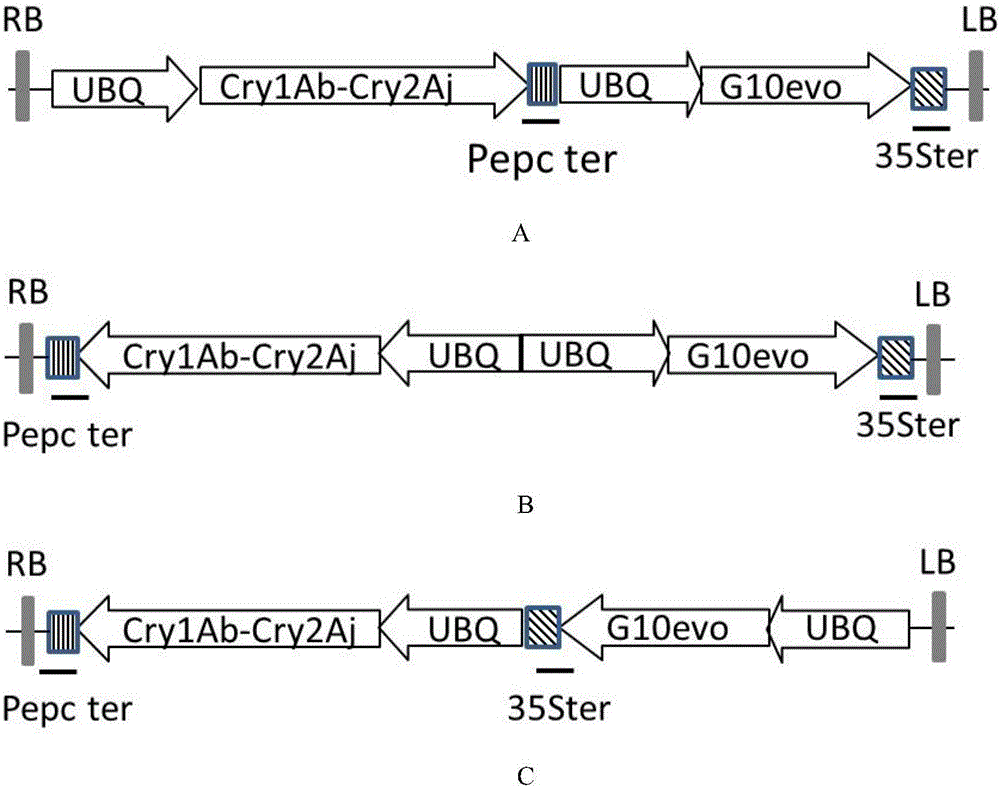Method for enhancing exogenous gene expression
A gene expression and exogenous gene technology, applied in the field of enhancing exogenous gene expression, can solve problems such as low transformation efficiency, and achieve the effects of improving expression, improving transcription level, and enhancing expression amount
- Summary
- Abstract
- Description
- Claims
- Application Information
AI Technical Summary
Problems solved by technology
Method used
Image
Examples
Embodiment 1
[0017] Example 1 Maize Transformation Vector Construction
[0018] The insect-resistant expression cassette was constructed by connecting the Polyubiqutin-1 promoter derived from corn, the insect-resistant fusion gene and the PEP carboxylase gene (pepc) terminator of corn to form an insect-resistant expression cassette using conventional molecular biology techniques. The nucleotide sequence is SEQ ID NO:2.
[0019] The glyphosate-resistant expression cassette is constructed by connecting the polyubiqutin-1 promoter derived from maize, a glyphosate-resistant gene encoding the chloroplast signal peptide of the AHAS gene at the 5' end, and the PEP carboxylase gene (pepc) terminator of maize. The glyphosate-resistant expression cassette has a nucleotide sequence of SEQ ID NO:4.
[0020] Using the Cambia1300 (Cambia, AU, carrier sequence numbered as AF234296.1 in NCBI) carrier as the framework, the gene part in the carrier T-DNA was removed by XhoI and KpnI double enzyme digestion...
Embodiment 2
[0028] The method used to obtain maize transformation events in this study is the Agrobacterium-mediated method, according to the method and medium formulation reported by Frame et al. (Bronwyn R.Frame.et.al.Agrobacterium tumefaciens-Mediated Transformation of Maize Embryos Using a Standard Binary Vector System, Plant Physiol, 2002,129:13-22) is transformed, and glyphosate is used as a screening reagent, and the specific steps are as follows:
[0029] (1) Take parental corn ears 8-10 days after pollination, and collect immature embryos with a size of 1.0-1.5 mm. The Agrobacterium containing the transformation vector prepared in Example 1 was co-cultured with immature embryos at 22° C. for 2-3 days.
[0030] (2) Transfer the immature embryos cultured in step (1) to a callus induction medium containing a final concentration of 200 mg / L Timentin antibiotic (GlaxoSmithKline, U.S.), and culture in the dark at 28°C for 10-14 days to kill Agrobacterium.
[0031] (3) Transfer all th...
Embodiment 3
[0037] (1) Screening of single-copy transgenic maize
[0038] Identification of foreign gene insertion copy number
[0039] Southern analysis was performed on the obtained transgenic maize using Roche (DIG High Prime DNA Labeling and Detection Starter Kit II, Roche), and hybridization probe preparation and DNA hybridization detection were performed following the operation steps provided by the kit. That is, the corn genomic DNA is extracted, digested with restriction endonucleases BamHI and XbaI respectively (these restriction endonucleases have a single recognition site in the exogenous gene), electrophoresis on agarose gel to separate the digested fragments, and then The DNA was transferred to the nylon matrix membrane, and the sequence of G10eve (2021-3535bp in the nucleotide sequence SEQ ID NO.4) labeled with digoxigenin was used as a probe to hybridize to the nylon matrix membrane and then fluorescently visualized to obtain a single signal band as Single-copy transgenic ...
PUM
 Login to View More
Login to View More Abstract
Description
Claims
Application Information
 Login to View More
Login to View More - R&D
- Intellectual Property
- Life Sciences
- Materials
- Tech Scout
- Unparalleled Data Quality
- Higher Quality Content
- 60% Fewer Hallucinations
Browse by: Latest US Patents, China's latest patents, Technical Efficacy Thesaurus, Application Domain, Technology Topic, Popular Technical Reports.
© 2025 PatSnap. All rights reserved.Legal|Privacy policy|Modern Slavery Act Transparency Statement|Sitemap|About US| Contact US: help@patsnap.com



